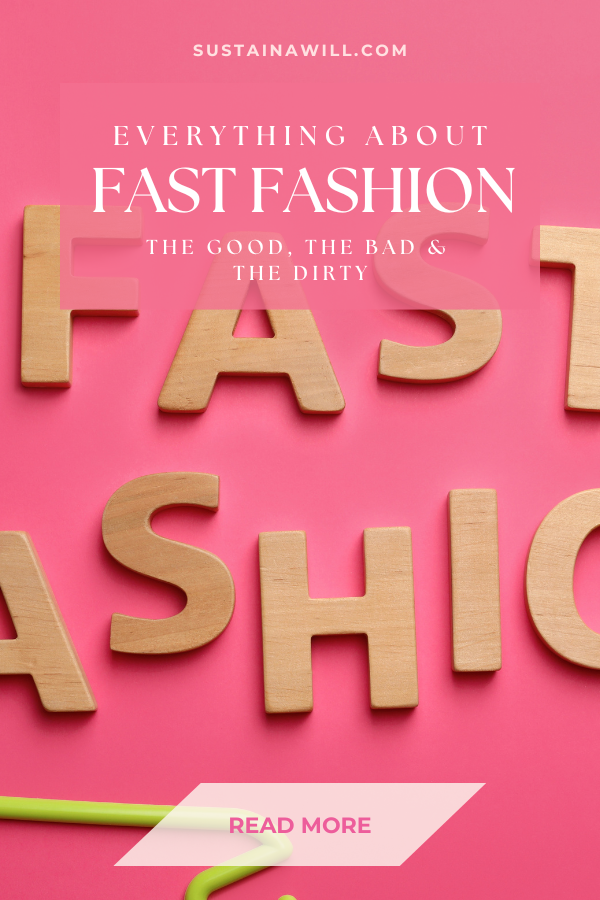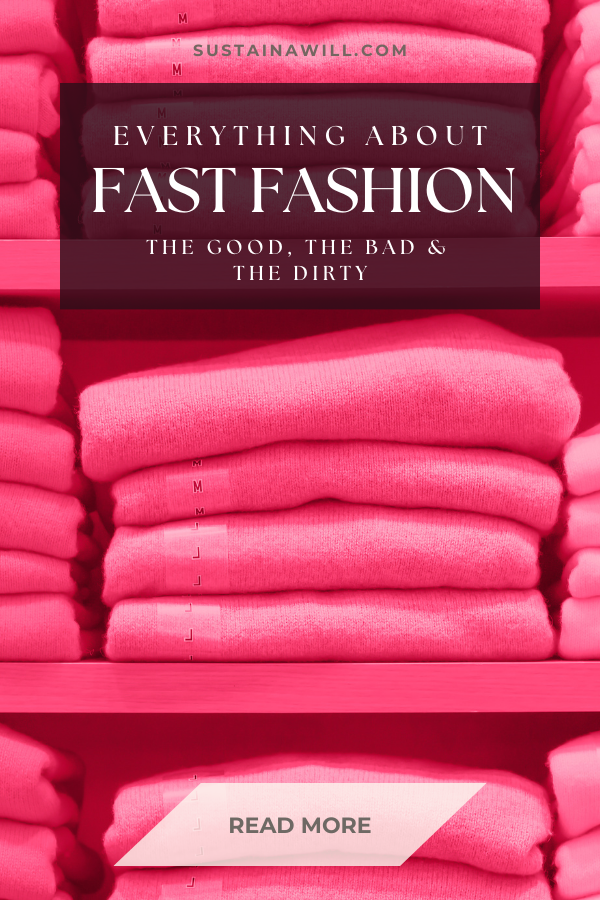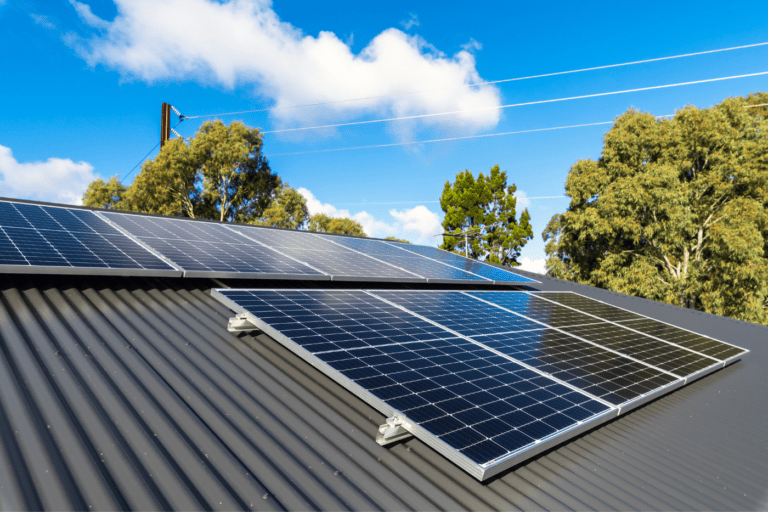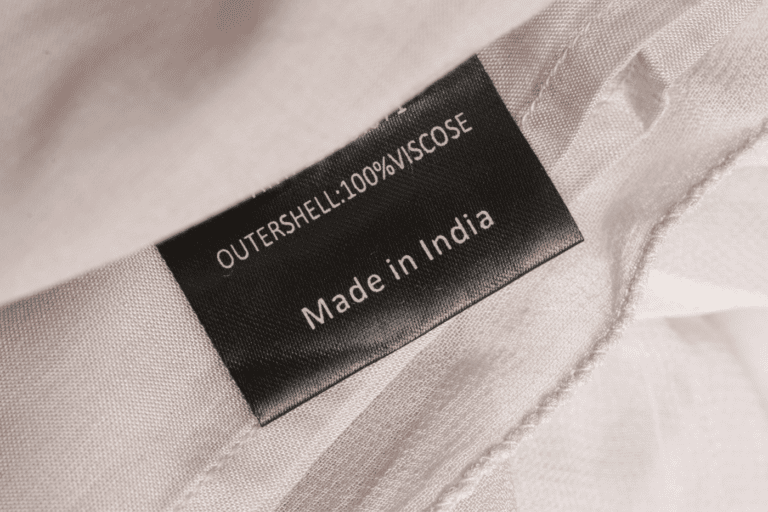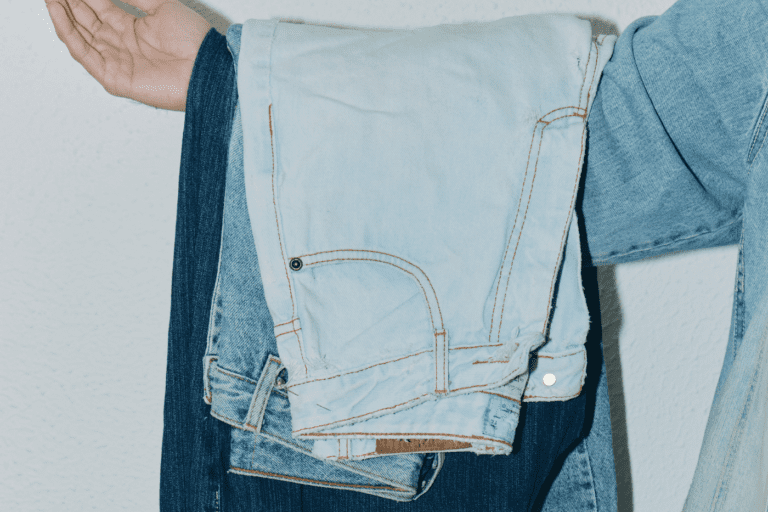Have you ever felt the irresistible allure of Fast Fashion, the thrill of staying on-trend, and the joy of bagging a fashion steal?
Yet, in the back of your mind, have you pondered the hidden costs, the environmental consequences, and the ethical questions that often accompany these dazzling displays of affordability?
In this blog post, we’ll delve into the world of Fast Fashion, revealing its known culprits and shedding light on the issues you might not even know you’re grappling with.
What Exactly Is Fast Fashion?
Fast Fashion is a fashion industry model that focuses on producing and delivering trendy, affordable clothing quickly to meet consumer demand for the latest styles.
Understanding Fast Fashion
- Fast Fashion is like the “fast food” of clothing. Just as fast food is quickly prepared and served, Fast Fashion gets trendy styles from the runway to the stores in no time.
- Imagine this: a designer’s new collection is showcased during a fashion show, and within weeks, those very designs are available at your local store. It’s fashion on fast-forward!
The Need for Transparency
Picture this: You find a gorgeous, low-priced dress at your favorite store, and it seems like a steal. But, did you ever wonder how they can make it so cheap? What’s the real cost behind that price tag?
Now, imagine being able to see through the whole process, from how the fabric was made to the conditions in which the workers produced the dress.
Transparency is like turning on the lights in a once-dark room, revealing what’s happening behind the scenes.
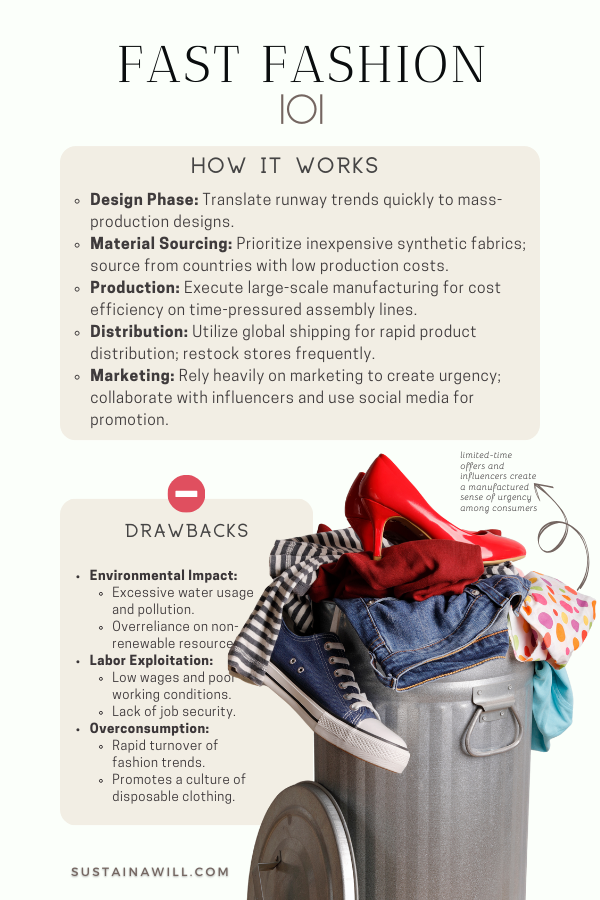
The Economic Machine Behind Fast Fashion
Fast fashion is like a well-oiled money-making engine, and we’re here to break it down into bite-sized pieces so you can understand it clearly.
Supply Chain Dynamics

- Speed is the Game: Fast fashion lives up to its name by streamlining the supply chain. Traditional fashion takes months to go from design to store, but fast fashion does it in weeks. How? By cutting out the middleman, using local manufacturers, and making quick decisions.
- The Zara Model: Ever heard of Zara? They’re masters at this game. Zara’s parent company, Inditex, owns many of its manufacturing facilities. This vertical integration gives them more control over production processes, so they can respond rapidly to trends. They produce in relatively smaller quantities and restock often, reducing the risk of unsold inventory.
- Vertical Integration: Many fast fashion brands own their manufacturing facilities, enabling them to control quality and speed. This vertical integration keeps costs down and profits up. While also ensuring the best possible control over the manufacturing process.
Profit-Driven Strategies

Low-Cost Labor
Let’s not sugarcoat it – a big part of fast fashion’s success comes from cheap labor in countries with lower labor costs. This keeps production costs low, and companies can offer rock-bottom prices to consumers.
Mass Production
Think of the giant factories churning out thousands of identical items. By making lots of the same thing, they save on setup costs and achieve economies of scale. It’s all about quantity.
Marketing and Hype
Fast fashion brands are pros at creating demand. They use limited-time offers, influencer marketing, and social media to make consumers feel like they need to buy now or miss out. FOMO, anyone?
Synthetic Fabrics
The fast fashion industry’s reliance on synthetic fabrics, like polyester, is driven by cost-effectiveness. These materials, derived from petrochemicals, enable mass production at low expenses.
While economically viable, the environmental impact is substantial. Read more about the environmental repercussions of synthetic fabrics in-depth under “DIRTY LITTLE SECRET: SYNTHETIC FABRICS’ BIG ENVIRONMENTAL IMPACT” here.
Globalization and Market Trends

- Global Sourcing: Fast fashion isn’t limited to one country. It’s a worldwide effort. Fabrics are sourced from one place, garments are stitched in another, and they might be shipped off to a third before landing in your local store. This globalization maximizes efficiency.
- Trend Chasing: Fast fashion is always chasing trends, and it does so with lightning speed. They watch what’s hot on the runways, in movies, and on social media, then produce their versions quickly.
- Consumer Demand: Fast fashion is all about giving consumers what they want, even before they realize they want it. They constantly adapt to ever-changing market trends to keep you coming back for more.
So, there you have it – the economic machine behind fast fashion. It’s a combination of a neatly calculated supply chain, profit-driven strategies, and keeping a sharp eye on global market trends.
Now that you’re in the know, you can decide how you want to engage with this fast-paced industry.
What Environmental Impact Does Fast Fashion Have?
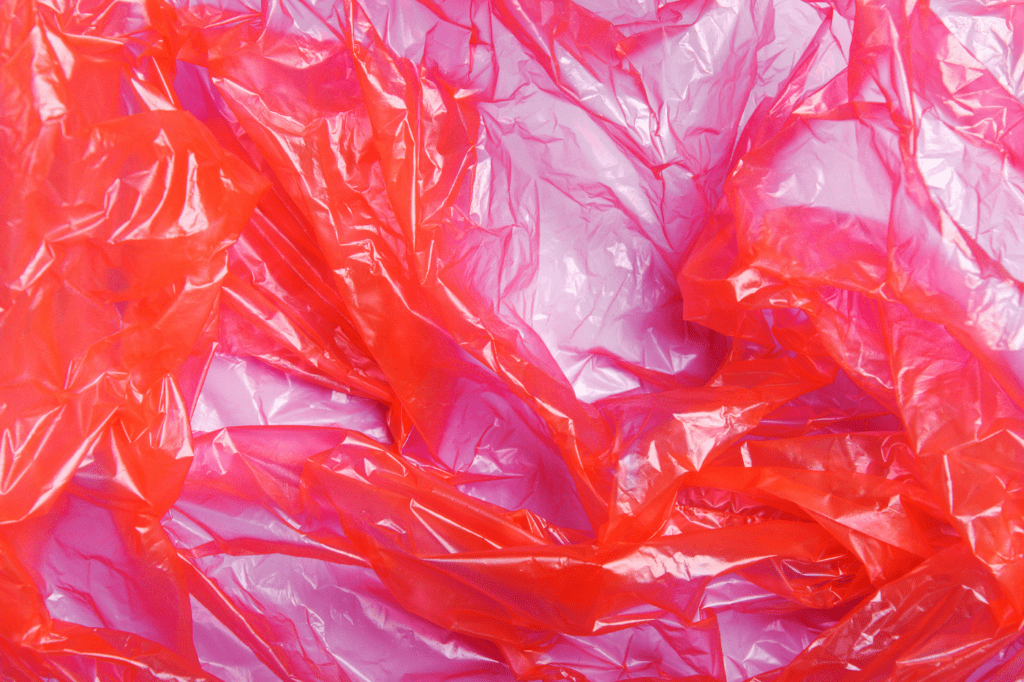
Resource Depletion
- Cotton Cultivation Impact:
- Cotton, a staple in fast fashion, requires extensive land, water, and pesticide use, contributing to soil degradation and water scarcity.
- Synthetic Fiber Demands:
- The production of synthetic fabrics like polyester relies heavily on fossil fuels, contributing to resource depletion and environmental strain.
- Water Intensive Processes:
- Both cotton and synthetic fabric production involve water-intensive processes, exacerbating water scarcity concerns in various regions.
Pollution and Waste
- Chemical Runoff:
- Pesticides and chemicals used in conventional cotton farming contaminate water sources, posing risks to ecosystems and human health.
- Dyeing and Finishing Processes:
- The dyeing and finishing stages of textile production release harmful chemicals into waterways, contributing to water pollution.
- Landfill Overflow:
- Fast fashion’s disposability results in vast amounts of clothing ending up in landfills, leading to environmental pollution and a waste crisis.
The Role of Textile Production
- High Energy Consumption:
- Textile manufacturing, especially for synthetic fabrics, is energy-intensive, relying on non-renewable resources and contributing to carbon emissions.
- Chemical Usage:
- The use of various chemicals in textile production, from dyes to finishing agents, poses environmental and health risks throughout the supply chain.
- Global Transportation Impact:
- The global nature of textile supply chains involves extensive transportation, contributing to carbon emissions and air pollution.
So, you see, Fast Fashion isn’t just about stylish clothes; it has a significant impact on the environment.
But don’t worry; we’re here to explore this in more detail and discover how we can make more sustainable choices while still staying trendy. Ready to dive in?
Ethical and Labor Concerns

Exploitative Practices
- Main Concerns:
- Unfair wages
- Unsafe working conditions
- Lack of worker rights
Ever bought a dirt-cheap item and wondered how it could be so inexpensive? Often, it’s because some brands cut corners.
They might use exploitative practices, like underpaying workers or compromising their safety.
Sweatshops and Worker Rights
- Main Concerns:
- Sweatshop conditions
- Violation of labor laws
- Lack of worker representation
When you hear “sweatshops,” what comes to mind? Overcrowded, unsanitary conditions where workers toil for long hours in unsafe environments?
Sadly, that’s the reality for some in the fashion industry.
Social Responsibility
- Main Concerns:
- Ensuring fair wages
- Providing safe working environments
- Upholding workers’ rights
In the world of fashion, social responsibility means taking care of those who make the clothes.
It’s about ensuring fair wages, safe conditions, and respect for workers’ rights.
Understanding these concerns and the impact they have on the fashion industry helps you make informed choices and advocate for a more ethical and fair fashion landscape.
How Does Consumer Behavior Influence Fast Fashion?

The Allure of Fast Fashion
Fast Fashion is like a magnetic force in the fashion world, attracting shoppers with its irresistible appeal. It’s like a decadent dessert display you can’t resist.
- Trendy Styles: Fast Fashion offers you the latest runway-inspired styles, so you can always look chic and current.
- Budget-Friendly: It’s all about the great deals. Fast Fashion makes it possible to stay stylish without emptying your wallet.
- Frequent Updates: Just as you crave new dessert options, Fast Fashion constantly introduces fresh clothing options, keeping you eager for more.
Impulse Buying and Overconsumption
Impulse buying is a common phenomenon in the Fast Fashion world. It can lead to a closet full of clothes you rarely wear.
- Unplanned Purchases: Fast Fashion often tempts you into buying things you didn’t intend to. It’s akin to that mouthwatering dessert menu that lures you in.
- Accumulation of Unworn Items: Impulse buys can result in a wardrobe filled with pieces you hardly use, much like having too many uneaten desserts.
- Environmental Impact: The cycle of buying and discarding takes a toll on the environment, as does excessive dessert consumption on your health.
Mindful Consumer Choices
Being a mindful consumer means making conscious decisions about your purchases.
- Thoughtful Shopping: Mindful consumer choices involve considering the environmental and ethical aspects of your purchases.
- Balancing Wants and Needs: It’s about finding the sweet spot between what you desire and what’s sustainable for you, much like enjoying dessert in moderation.
- Supporting Ethical Brands: Just as you might choose desserts made with high-quality ingredients, you can opt for brands committed to fair labor practices and sustainable production.
What Is the Slow Fashion Movement About?

While fast fashion races to keep up with the latest trends, there’s a contrasting movement gaining momentum – the Slow Fashion movement. This fashion revolution is all about mindful choices and sustainability.
Let’s explore what it’s all about:
Embracing Sustainable Fashion
- Quality Over Quantity: Slow fashion emphasizes owning fewer, high-quality items that last longer. It’s all about investing in pieces that won’t fall apart after a few wears.
- Ethical Production: Slow fashion brands prioritize fair labor practices and ensure that workers are paid well and work in safe conditions. It’s a stark contrast to the exploitative practices seen in fast fashion.
- Eco-friendly Materials: Slow fashion is all about using sustainable materials – think organic cotton, bamboo, and recycled fabrics. The goal is to reduce the environmental impact of clothing production.
Artisanal and Local Alternatives
- Handcrafted Delights: Slow fashion celebrates artisanal craftsmanship. Many items are handmade or have hand-finished details, making each piece unique.
- Local Sourcing: Instead of shipping materials and products halfway across the world, slow fashion often sources materials locally and manufactures close to home. This not only supports local economies but reduces the carbon footprint.
- Customization: Some slow fashion brands offer customization options, allowing you to choose the color, style, and details of your garment. It’s like having a say in the design.
Slow Fashion Brands
- Patagonia: Known for its environmental initiatives and commitment to sustainability, Patagonia is a prime example of a slow fashion brand. They repair and recycle their products and encourage customers to do the same.
- Eileen Fisher: Eileen Fisher is all about timeless designs and sustainable materials. They even have a take-back program, where they buy back old pieces to resell or recycle.
- People Tree: A pioneer in fair trade and organic fashion, People Tree collaborates with skilled artisans and farmers in developing countries to create beautiful, sustainable clothing.
The Slow Fashion movement is an antidote to the fast fashion frenzy. It encourages us to be mindful consumers, supporting brands that prioritize ethics, quality, and sustainability.
So, next time you’re thinking about refreshing your wardrobe, consider giving slow fashion a try. It’s fashion with a conscience!
What Solutions and Alternatives Exist for Fast Fashion?

Sustainable Fashion Innovations
- Eco-Friendly Fabrics: Look for clothing made from sustainable materials like organic cotton, Tencel, or recycled fabrics. These options are kinder to the environment.
- Circular Fashion: Consider brands that promote a circular fashion economy. They focus on recycling and upcycling, ensuring that garments don’t end up in landfills.
- Renting and Sharing: Why buy when you can rent? Many platforms offer rental services for clothing, so you can rock that special outfit without the commitment.
Supporting Ethical Brands
- Research and Choose Wisely: Investigate brands’ ethical practices and values. Seek out companies that prioritize fair wages, safe working conditions, and sustainability.
- Local and Artisanal Brands: Support local artisans and small-scale brands that often have a stronger connection to their products and take pride in craftsmanship.
- Transparency Matters: Brands that are transparent about their supply chain and manufacturing processes are often more trustworthy. Look for those that disclose this information.
Personal and Industry Responsibility
- Buy Less, Choose Well: One of the simplest ways to combat fast fashion is to buy less. Invest in high-quality, timeless pieces that will last longer and never go out of style.
- Wardrobe Makeovers: Get creative with your wardrobe. Reimagine old clothing, repair items, and consider alterations to give them new life.
- Educate and Advocate: Use your consumer power to promote ethical practices. Educate yourself about fashion’s impact and share that knowledge with others. Advocate for change in the industry.
- Sustainable Fashion Movements: Support and get involved in sustainability movements like Slow Fashion, the Sustainable Apparel Coalition, or Fashion Revolution.
In a world of fast fashion, making sustainable choices might seem like a drop in the ocean, but remember that every drop counts.
By exploring sustainable fashion innovations, supporting ethical brands, and taking personal and industry responsibility, you can play a vital role in transforming the fashion industry into a more conscious and eco-friendly one.
So, let’s make mindful fashion choices and embrace a more sustainable future!
Conclusion
The next time you’re tempted by a fast fashion bargain, pause. Consider the true cost, not just in dollars and cents but in environmental impact and human lives.
Look to the sustainable and ethical alternatives we’ve discussed. Choose quality over quantity, conscious consumerism over impulse buying.
By doing so, you’re not just revolutionizing your wardrobe; you’re taking a stand against a system that prioritizes profit over people and the planet. Together, we can redefine fashion, making it a force for good in the world.
The rush for fast fashion may be addictive, but the rewards of mindful and sustainable choices are far more enriching – for your closet, your conscience, and our planet.
